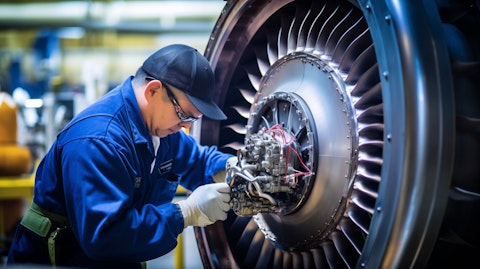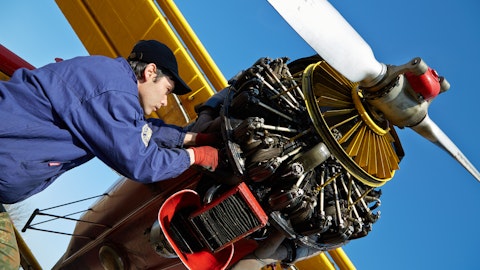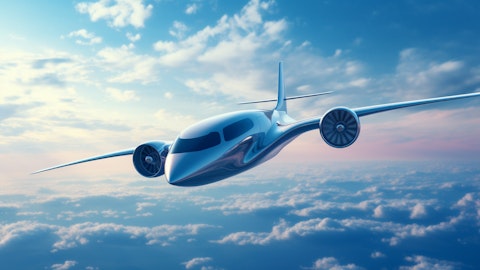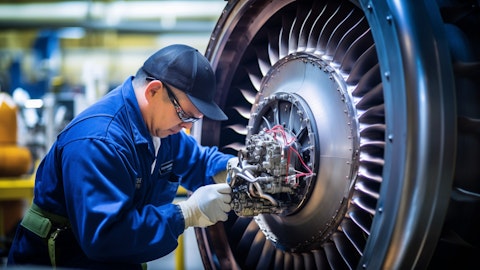AAR Corp. (NYSE:AIR) Q3 2024 Earnings Call Transcript March 21, 2024
AAR Corp. beats earnings expectations. Reported EPS is $0.85, expectations were $0.84. AIR isn’t one of the 30 most popular stocks among hedge funds at the end of the third quarter (see the details here).
Operator: Good afternoon, everyone. Welcome to AAR’s Fiscal 2024 Third Quarter Earnings Call. We’re joined today by John Holmes, Chairman, President and Chief Executive Officer; and Sean Gillen, Chief Financial Officer. Before we begin, I’d like to remind you that the comments made during the call may include forward-looking statements as defined in the Private Securities Litigation Reform Act of 1995. These forward-looking statements involve risks and uncertainties that could cause actual results to differ materially from the forward-looking statements. Accordingly, these statements are no guarantee of future performance. These risks and uncertainties are discussed in the company’s earnings release and the Risk Factor sections of the company’s annual report on Form 10-K for the fiscal year ended May 31, 2023, and Form 10-Q for the fiscal quarter ended February 29, 2024, which we expect to be on file with the SEC shortly.
In providing the forward-looking statements, the company assumes no obligation to provide updates to reflect future circumstances or anticipated or unanticipated events. Certain non-GAAP financial information will be discussed in the call today. A reconciliation of these non-GAAP measures to the most comparable GAAP measures is set forth in the company’s earnings release. A replay of this conference call will be available for on-demand listening shortly after the completion of the call on AAR’s website. At this time, I would like to turn the call over to AAR’s Chairman, President and CEO, John Holmes.
John Holmes: Thank you, and good afternoon, everyone. I appreciate you joining us today to discuss our third quarter fiscal year 2024 results. Before we discuss the results, I would like to take the opportunity here to, again, welcome the Triumph Product Support employee to the AAR family. We closed the acquisition and related financing transactions just subsequent to the end of our quarter. This business, which is now part of our Repair & Engineering segment, meaningfully scales our previous component repair operation, adds differentiated repair capability on both current and next-generation platforms, and expands our footprint into the higher growth Asian market. Integration is off to a great start and I am very, very excited about what we can do with this business.
Turning to the results, we delivered another strong quarter. Specifically, sales were up 9% year-over-year from $521 million to a third quarter record of $567 million. Sales to commercial customers increased 18%, more than offsetting a 7% decrease in sales to government customers. For Parts Supply, total sales were up 6% year-over-year, driven by strong performance in our Commercial Distribution business. In USM, demand remains exceptionally strong, which drove another quarter of growth. To break that down further, individual USM sale — part sales were up significantly year-over-year, but large asset transactions, such as whole aircraft and whole engine sales, were down. This reflects even tighter supply in this market. For example, opportunities like the 757 acquisition that we made from American Airlines last year are even more difficult to find.
Having said that, we have the best sourcing team in the world and continue to have the balance sheet flexibility to be able to act quickly when those opportunities do arise. I mentioned strong commercial distribution performance and I would like to highlight that specifically. Commercial distribution had an exceptional quarter, posting 27% organic growth. This was driven by growth from existing product lines, as well as the early ramp of recently announced wins. Government distribution had a lower quarter when compared to a very strong quarter a year ago. However, government bookings have been increasing and we expect growth to return to that business moving forward. In Repair & Engineering, sales were up 10% over the prior year quarter as we were able to drive greater volumes through our hangers.
I’m proud of the efficiency gains we continue to make with our existing footprint. In Integrated Solutions, sales were up 15% over the prior year quarter due to increased flight hours in our commercial Power-by-the-Hour program and the contribution from Trax. Finally, in Expeditionary Services, sales were down 15% over the prior year quarter due to a decline in shipments of pallets to the U.S. Air Force. As a reminder, we are the sole source provider of these pallets and we expect the DoD’s procurement volumes to return to more normalized levels in our FY 2025. Turning to profitability, our adjusted operating margin was 8.3%, up from 7.6% in the prior year quarter, driven by margin expansion in Parts Supply and Repair & Engineering. This represents our 12th straight quarter of year-over-year adjusted operating margin expansion and our margins are now approximately 50% higher than they were before COVID.
We are especially proud to have made this progress in an inflationary environment in which labor costs in particular have been rising. Our adjusted diluted earnings per share from continuing operations were up 13% from $0.75 per share to a third quarter record of $0.85 per share. With respect to cash, we generated $20 million in cash flow from operating activities from continuing operations. Our cash flow and EBITDA growth resulted in net leverage at quarter end of just under 1 times adjusted EBITDA. As you know, we elected to finance the Product Support acquisition entirely with new debt. Pro forma for the acquisition net leverage at the end of Q3 was 3.6 times adjusted EBITDA. The decision to finance entirely with debt reflects our confidence in the continued cash flow generation and EBITDA growth and our resulting ability to delever.
Turning to new business during the quarter, we announced a new multiyear distribution agreement with Ontic to supply certain military products to the U.S. Government. We also announced a multiyear contract extension and expansion for flight hour component support services with ASL Airlines. We also announced Trax agreements to provide eMRO services to Singapore Airlines, as well as eMRO and eMobility services to Archer Aviation. The Singapore Airlines award in particular demonstrates the power of the AAR track combination as AAR was instrumental in securing that award. Finally, just yesterday morning, we announced an agreement to provide surplus CFM56-5B engine material to Cebu Pacific. This agreement leverages our long-term supply partnership with FTAI Aviation and drives further predictability into our USM operations.

With that, I’ll turn it over to our CFO, Sean Gillen, to discuss the results and the acquisition in more detail.
Sean Gillen: Thanks, John. Our sales in the quarter of $557.3 million were up 8.9% year-over-year. Our commercial sales were up 17.6% year-over-year, driven by commercial growth in each of Parts Supply, Repair & Engineering and Integrated Solutions. Our commercial distribution sales were a particular standout as we continue to drive sales growth on existing product lines and expanded newly won product lines as well. Our government sales were down 7.4% year-over-year. However, sequentially, government sales were up 5% as we have started to see a recovery in our government activities within distribution, Integrated Solutions and Expeditionary Services. Gross profit margin in the quarter was 19.4%, up from 18.1% in the prior year quarter, driven by strong performance in Parts Supply, as well as Integrated Solutions, including the high margin tracks offering.
Gross profit margin in our commercial business was 19.8% and gross profit margin in our government business was 18.6%. SG&A expenses in the quarter were $77 million. This included $9.4 million of Triumph Product Support transaction expenses, $2.8 million of Trax acquisition and amortization expenses, and $2 million of investigation costs. Excluding these items, SG&A was $62.8 million or 11.1% of sales. Net interest expense for the quarter was $11.3 million, which included $6.1 million of costs related to the bridge financing commitment for the Product Support acquisition that will not recur going forward. Cash flow provided by operating activities and continuing operations was $20.4 million. This is net of inventory investments in Parts Supply, specifically in commercial distribution, which as we’ve mentioned, has significant sales growth in the quarter.
Our net leverage at the end of Q3 was 0.95 times. As John indicated, we financed the Product Support acquisition entirely with new debt, consisting of $550 million of unsecured notes with an interest rate of 6.75% and an approximately $205 million incremental draw from our revolving credit facility, which we upsized by $205 million in conjunction with the acquisition. In Q4, we expect our net interest expense to be approximately $18.5 million, which consists of $9.3 million associated with the fixed rate notes and the balance from the floating rate revolver and the amortization of financing expenses. Going forward and consistent with our reporting for Trax, our adjusted operating income and adjusted EPS will exclude non-cash amortization expense associated with purchase accounting.
Our adjusted results will also exclude transaction expenses recognized in Q4, as well as integration costs that we expect to incur over the next 12 months to 18 months. As a reminder, we indicated that we expect to generate $10 million of run rate synergies from the Product Support acquisition and expect that it will be accretive in full year fiscal 2025. However, in Q4, we expect it to be slightly diluted to earnings as the incremental interest expense associated with the acquisition will modestly exceed incremental operating process. As we also indicated previously, we will step up the tax basis, which will generate approximately $9 million of annual cash tax savings for each of the next 15 years. This will not impact our GAAP tax rate or adjusted EPS and we expect our adjusted effective tax rates to be approximately 27.5%.
Before turning the call back to John, I would like to take this opportunity to thank our bank group for their support of the financing of the acquisition. Their additional $205 million commitment to our revolver reflects their confidence in AAR and the merits of the acquisition, and allowed us to partially finance the acquisition with flexible pre-payable debt that facilitates our delevering going forward. Thank you for your attention and I will now turn the call back over to John.
John Holmes: Great. Thank you, Sean. Regarding the market going forward, the continued new aircraft delivery challenges, as well as the GTF and other engine issues means the demand for current generation aircraft and associated maintenance and parts requirements will remain strong. This is good news for AAR. While this means that USM supply will remain tight, we will continue to leverage our global surfing network to secure materials to meet this demand. This also means sustained high demand for our commercial distribution activities where we expect significant growth to continue, coming from both existing lines, as well as new contract awards. In Repair & Engineering, I am excited to announce that we expect to break ground on our airframe MRO facility expansions in both Miami and Oklahoma City this quarter.
Once complete in our FY 2026, these will add approximately 15% capacity to our network. In the meantime, we will look for ways to drive growth and higher throughput utilizing our existing footprint like we did this quarter. In Integrated Solutions, we have a strong pipeline of both government and commercial opportunities, and we expect awards will be made this calendar year. We are also encouraged by the high level of customer interest in the Trax eMRO suite of offerings. Regarding Q4, we expect revenue growth in the mid- to high-teens, including the contribution from the Product Support acquisition of approximately $65 million to $70 million in sales. And we expect adjusted operating margins of approximately 9% overall, which reflects the accretive contribution from the Product Support acquisition.
More generally, we are incredibly well positioned to continue our growth and margin expansion as we move into our FY 2025 and beyond. The Trax acquisition is working well and the thesis behind the combination is proving out as evidenced by the recently announced Singapore win. We are incredibly excited about the differentiated high margin capability that the Product Support acquisition brings and our team is already pursuing numerous opportunities with our customers. Overall, our end markets are extremely strong and we remain focused on executing on our growth strategy. With that, I’ll turn it over to the operator for questions.
See also 15 Countries with Most Climate Refugees in the World and 20 Countries with the Worst English Accents in the World.
Q&A Session
Follow Aar Corp (NYSE:AIR)
Follow Aar Corp (NYSE:AIR)
Operator: Thank you. [Operator Instructions] And our first question will come from the line of Robert Spingarn with Melius Research. Your line is open.
Robert Spingarn: Well, good afternoon.
John Holmes: Hey, Rob. How are you?
Robert Spingarn: Good. Thanks. Hope you guys are well. I have a few different questions here. John, first, I thought I’d go back to a couple of your comments on the business and this concept of a slower OE ramp leaving more older aircraft in service longer. How is that, clearly it’s driving the Parts business. How is that affecting MRO? Because I’m curious if that’s increasing demand or lowering it, because you just can’t get airplanes out of an airline schedule long enough to work on them.
John Holmes: Yeah. That’s a really great question. With respect to your first point on Parts, absolutely. The longer the current generation aircraft is in operation, and obviously, you’re seeing very high utilization, the more parts requirements it’s going to drive. So it’s good news for the Parts business. For the Heavy Maintenance business, over the medium-term, it will be a positive. It will drive more maintenance requirements. You’ve got aircraft that were expected to be retired that are now going to end up going in for another maintenance event. However, in the immediate term, it is driving a lot of movement in the maintenance schedules at the airlines, as airlines like United and Southwest, two of our big customers look to move things around to adjust to the new delivery schedules that they’re getting out of the OEM.
So it’s creating a little bit of churn for us in the medium-term — in the immediate term, but on a balance, it will be a positive for us.
Robert Spingarn: Okay. And then just focusing on Parts Supply, just wanted to think about sequentially through the quarter. The year-on-year growth at 6.5% was solid, but we might have expected a little bit higher, you had good margins, but just on the topline growth…
John Holmes: Yeah.
Robert Spingarn: … and then comparing to prior quarters, how do we think about that 6.5% when we look through the various months of the quarter in terms of front of quarter, back of quarter? Is there a trend?
John Holmes: I wouldn’t point to much of a trend throughout the quarter. I mean, it’s fairly steady, but I would parse that 6.5%, right? You’ve got really two kind of major buckets in there. You’ve got new parts distribution and then you’ve got USM. And within those two buckets, I want to take you a level further. So in new parts distribution, the commercial business, as we mentioned, just had an outstanding quarter. We’re 27% organic growth year-over-year in new parts commercial distribution. And if you look at our peer set, that’s about the best that you see out there. So we’re really happy with the way commercial distribution is going. Government distribution had a lower quarter than it did last year. Last year, we had a very strong quarter.
This year we also had a good quarter. It was just lower than last quarter. We had seen bookings and I believe we’ve talked about this in prior earnings calls, we had seen government bookings decrease throughout last year. So we’re feeling the effects of that now. On the flip side, we are now seeing government bookings increasing the last several months. So we expect that will drive return to growth in the government distribution as well. So, a couple of moving parts on the commercial — on the new parts distribution side. And then flipping over to USM…
Robert Spingarn: Okay.
John Holmes: … flipping over to USM, as we mentioned, we kind of break that down into two buckets. Large asset sales, which are whole aircraft and whole engines, and then the day-to-day parts sales. The day-to-day parts sales are at record levels. We saw double-digit growth in day-to-day parts sales in USM. Those packages of parts at this moment in time are easier to source. So we’re getting our hands on those and we’re repairing them and reselling them. The whole assets, the larger dollar assets, those are harder to come by, and so we saw a decline year-over-year in large asset sales. And obviously the focus of that team is to continue to leverage the global sourcing network to get our hands on the right assets to meet the demand. So anyway, I wanted to take you through, you got a few different moving parts below that 6.5% and hopefully that gives you a little more color.
Robert Spingarn: Yeah. And just on that comment you made a moment ago, why is it that the smaller batches of components and parts are — or of USM are easier to come by than the full aircraft, et cetera? I guess the full aircraft, if you have a full aircraft somewhere, an airline doesn’t want to let that go. They want to put that back up in service. Is that the reason?
John Holmes: Yeah. That’s exactly. You want the aircraft in service, and then in terms of whole engines, the engine shops are full right now. The slots are full. And so, if you’ve got a spare engine, you’re going to want it on a wing and operating.
Robert Spingarn: Okay. And then just one more on engines, given MAX and the gear turbo fan situations, with the airlines extending the lives of old aircraft and engines, we see a build out still with Pratt and CFM on their maintenance networks for these engines, GTF and LEAP. Do you have any interest in getting into the engine MRO market?
John Holmes: Yeah. That question comes up relatively frequently. At this time, our biggest customers in the trading business are the engine MROs themselves, the MTUs, Delta Tech Ops, et cetera. And so we’re not in the business of competing with our customers. Our preference is to be the supplier to support that broadening demand across the MRO — engine MRO network.
Robert Spingarn: Okay. And then just one quick one for Sean on margins. Just — they’ve been doing well. Your Parts business is strong. Within Repair & Engineering, strong demand for airframe MRO. And then with the Triumph asset and the Trax acquisitions, these being accretive to margins, could you be close to double-digit operating margins at some point in fiscal 2025?




